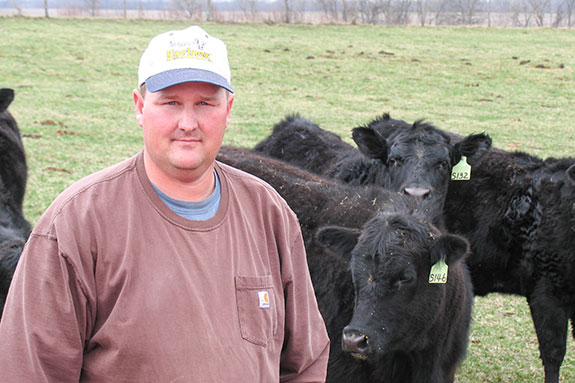“To make things work in the cattle business today, it takes information based on sound data,” Strohbehn says. “I enjoy figuring out what that sound data is and what it might tell us.”
The cooperative’s Sire Profit Analysis has grown from data on 35 sires in the initial report to 3,451 sires evaluated in 2012.
Matt Kleeman, who runs nearly 500 commercial Angus cows with his dad and brothers near Braymer, Missouri, appreciates the report. They’ve entered calves in TCSCF for nearly 10 years.
“It’s hard to tell just by looking at the bull on foot how it’s going to do as a sire,” he says. That’s true whether the sire is in a photograph or a local pasture.
All the heifers and some cows on the Kleeman operation are bred using artificial insemination (AI). But even with the higher level of proven genetics among AI sires, the family aims to verify the impact of expected progeny differences (EPDs) by looking at actual progeny differences from their cows.
That’s why they carefully pick sires they believe will perform best with their cows, then use this system to check on results. Of all the sires evaluated in the Sire Profit Analysis last year, the Kleemans had some ranking from the 99th profit percentile down to the 10th profit percentile.
“You may think a bull is doing a good job, but it may not do as well in the sire report or vice versa,” Kleeman says. “The Sire Profit Analysis ranks our bulls and tells us more about the carcass and feeding qualities of their calves.”

The Kleemans keep replacement breeding stock and can multiply positive results while cutting off lines that show less profit potential. In 2013 for example, the producers bred more females to one of their top-performing sires based on the report.
“Even though that summary tells us what the sire is doing, we can still trace that calf back to the maternal side as well,” Kleeman says. Data serves as a sorting tool for choosing replacement heifers and helps find the sire traits that best match their cows. If a calf crop does not perform as expected, they know to adjust the breeding to find a better combination.
By making changes on both the male and female sides, the fall and spring herds keep advancing on the goals of improving yield grades and garnering more quality premiums such as those for the Certified Angus Beef (CAB) brand. That adds more value to the carcasses, thanks in large part to information from TCSCF, Kleeman says.
“If we didn’t have the data back on our sires and retained ownership calves, we would not know which direction to go to improve our herd to become more efficient and profitable,” he notes.
The right sires will add value to any herd, but years of work on the Sire Profit Analysis project have shown Strohbehn there is no specific type of bull or breeding formula that guarantees the most profit.
However, one report compares traits of the top 25 percent to the bottom 25 percent profit bulls, and there are some common traits typically found in the top group, Strohbehn says.
“They tend to gain a little faster, have higher-quality grades, higher CAB percentages and higher percentages of USDA prime,” he explains. “But there’s a lot of variation to how those bulls look within both the high-percentile-range and low-percentile-range groups.”
Some of the best bulls may have exceptionally high-quality grades but below-average growth, he explains. Others may have perfect health with high gaining potential but below-average quality.
“There are some traits that are very significant,” Strohbehn says, “but they don’t explain all the variation in profit; no one trait does.”
Many cattle operations across North America have benefitted from TCSCF, but Strohbehn says more producers could gain from participation – especially those who assume their cattle are average in every trait.
“That is a mistake,” he emphasizes. “Collecting your own herd data and benchmarking it against data from others in the same environment or feeding group is a very powerful tool. It shows your herd’s strengths and weaknesses and can help build a road map for improvement.”
With detailed profit values and a full range of performance information from TCSCF, that map is only getting easier to follow. ![]()
—From Certified Angus Beef news release
PHOTOS
TOP: Daryl Strohbehn.
BOTTOM: Mike Kleeman. Photos courtesy of Certified Angus Beef.







